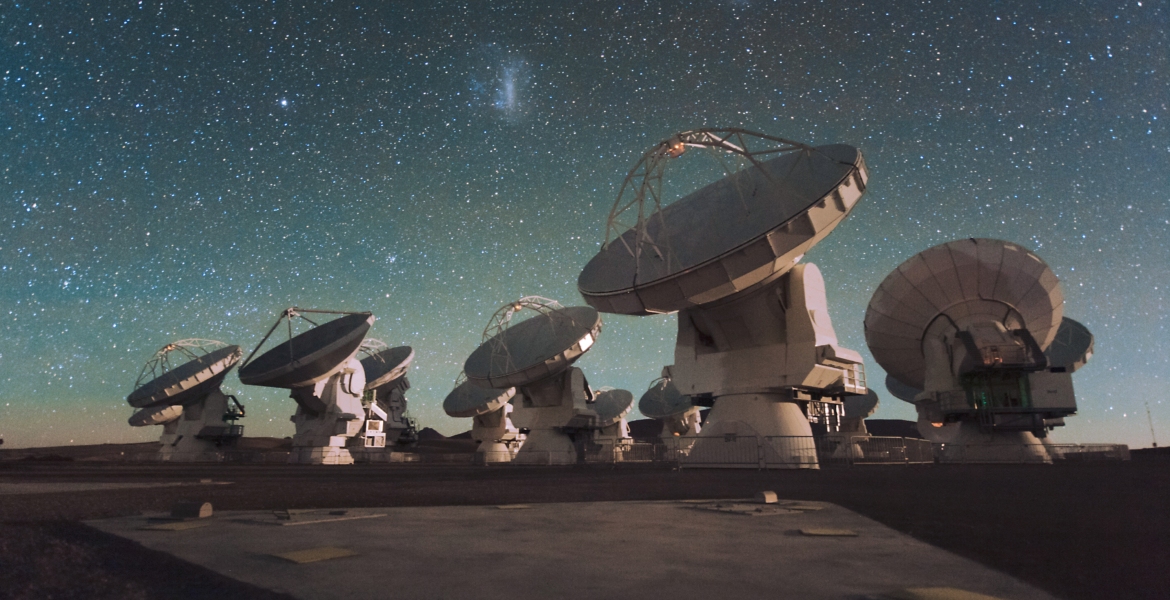The U.S. National Science Foundation National Radio Astronomy Observatory (NSF NRAO), in partnership with several leading Mexican universities and research institutes, has announced a series of landmark agreements and meetings aimed at advancing Mexico’s role in the Next Generation Very Large Array (ngVLA) project.
Recent News
Astronomers Discover a Superheated Star Factory in the Early Universe
Astronomers have uncovered a previously unknown, extreme kind of star factory by taking the temperature of a distant galaxy using the ALMA telescope. The galaxy is glowing intensely in superheated cosmic dust while forming stars 180 times faster than our own Milky Way.
Astronomers Share Largest Molecular Survey To-date: GOTHAM Legacy Data Goes Public
Astronomers in the “GBT Observations of TMC-1: Hunting Aromatic Molecules” research survey, known as GOTHAM, have released a spectral line survey with largest amount of telescope time ever conducted, charting more than 100 molecular species only found in deep space.
New US & Japan Partnership Will Make the World’s Most Powerful Telescope Even More Sensitive

The National Science Foundation’s National Radio Astronomy Observatory (NRAO) and the National Astronomical Observatory of Japan (NAOJ) are joining efforts to expand the capabilities of the world’s most powerful millimeter/ submillimeter telescope, the Atacama Large Millimeter/submillimeter Array (ALMA). In a little over two years, this collaboration will deliver high performance receiver components for Band 2, and accelerate the development of the significantly upgraded version of Band 6 receivers, known as Band 6v2, which are part of the ongoing Wideband Sensitivity Upgrade.
“This agreement speeds the development of ALMA’s Wideband Sensitivity Upgrade and establishes the groundwork for a promising longer term collaboration between NRAO and NAOJ,” shares Phil Jewell, NRAO North American ALMA Director. “ALMA is made possible by a major international collaboration, and it’s important to all partners that our telescope array remains a fundamental instrument for international astronomy for decades to come.”
Drawing upon the technical design, fabrication, and testing expertise of both organizations, new receiver components will be developed, fabricated, integrated, and tested. As part of these efforts, NRAO and NAOJ will collaborate in a design for a Superconductor-Insulator-Superconductor (SIS) mixer to be fabricated at NAOJ’s in-house facility, their Advanced Technology Center. This technology will greatly enhance the sensitivity of ALMA’s receivers.
NAOJ has already been collaborating with the European Southern Observatory to develop the initial six units of the Band 2 receiver. This agreement with NRAO will strengthen this partnership to deliver the rest. NRAO will use NAOJ’s relationship with specialized manufacturers to produce receiver components, including corrugated feed horns, waveguides and orthomode transducers. This will complete the second phase of the NAOJ/ESO project, to outfit the entire ALMA telescope array with Band 2 receivers.
For Band 6v2, NRAO and NAOJ engineers will investigate the performance of receiver optics, along with the design and fabrication of SIS mixers, with the intention of producing NRAO designs at the NAOJ facility. NAOJ will also design, test and produce prototypes of orthomode transducers for potential use in the Band 6v2 receivers.
“Through this agreement, NAOJ and NRAO will deepen our collaboration to make the most of our expertise for the production of the Band 2 receiver and the development of the Band 6v2 receiver, which are both key pieces of the ALMA2030 Wideband Sensitivity Upgrade,” adds Alvaro Gonzalez, NAOJ ALMA Project Director. “Joint efforts like this are crucial for sustainable long-term development in radio astronomy.”
About ALMA & NRAO
The Atacama Large Millimeter/submillimeter Array (ALMA), an international astronomy facility, is a partnership of the European Organisation for Astronomical Research in the Southern Hemisphere (ESO), the U.S. National Science Foundation (NSF) and the National Institutes of Natural Sciences (NINS) of Japan in cooperation with the Republic of Chile. ALMA is funded by ESO on behalf of its Member States, by NSF in cooperation with the National Research Council of Canada (NRC) and the Ministry of Science and Technology (MOST) and by NINS in cooperation with the Academia Sinica (AS) in Taiwan and the Korea Astronomy and Space Science Institute (KASI).
ALMA construction and operations are led by ESO on behalf of its Member States; by the National Radio Astronomy Observatory (NRAO), managed by Associated Universities, Inc. (AUI), on behalf of North America; and by the National Astronomical Observatory of Japan (NAOJ) on behalf of East Asia. The Joint ALMA Observatory (JAO) provides the unified leadership and management of the construction, commissioning and operation of ALMA.
The NRAO is a facility of the National Science Foundation, operated under cooperative agreement by Associated Universities, Inc.
This news article was originally published on the NRAO website on November 13, 2023.
Recent News
NSF National Radio Astronomy Observatory and Mexican Institutions Sign Historic Agreements to Advance ngVLA Collaboration
The U.S. National Science Foundation National Radio Astronomy Observatory (NSF NRAO), in partnership with several leading Mexican universities and research institutes, has announced a series of landmark agreements and meetings aimed at advancing Mexico’s role in the Next Generation Very Large Array (ngVLA) project.
Astronomers Discover a Superheated Star Factory in the Early Universe
Astronomers have uncovered a previously unknown, extreme kind of star factory by taking the temperature of a distant galaxy using the ALMA telescope. The galaxy is glowing intensely in superheated cosmic dust while forming stars 180 times faster than our own Milky Way.
Astronomers Share Largest Molecular Survey To-date: GOTHAM Legacy Data Goes Public
Astronomers in the “GBT Observations of TMC-1: Hunting Aromatic Molecules” research survey, known as GOTHAM, have released a spectral line survey with largest amount of telescope time ever conducted, charting more than 100 molecular species only found in deep space.
